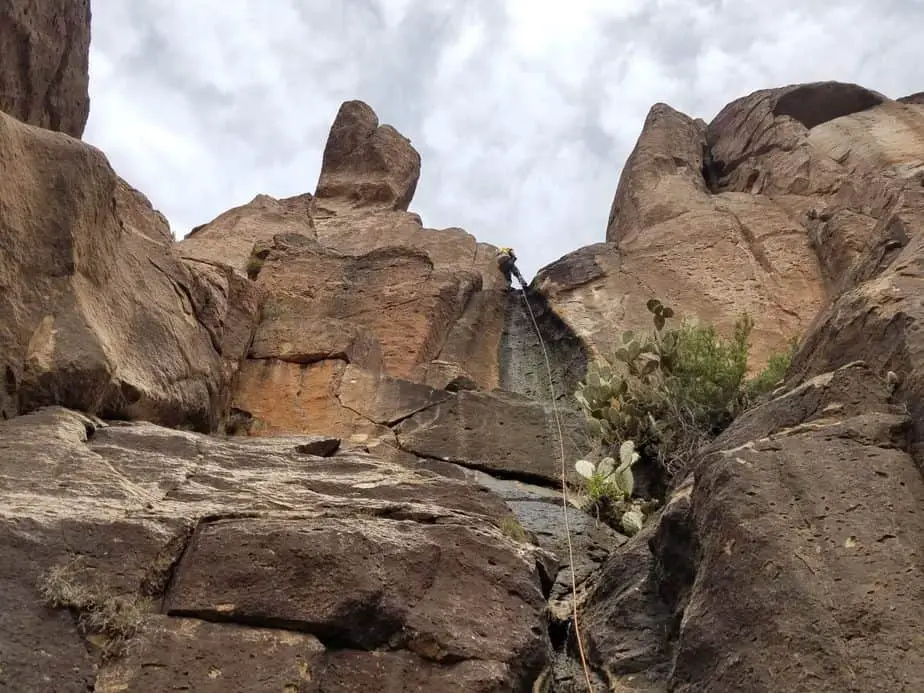No matter where you are in Arizona, there are amazing canyons dotted throughout the state. Arizona is one of my favorite places for canyoneering. There is some of everything when it comes to types of canyons and experience level. Arizona has a lot to offer with beautiful desert scenery, stunning rock formations, green mountain areas, and spectacular views. Here you’ll find the 7 best beginner canyons in Arizona.
- Bunker Hills Spring Canyon (Sedona)
- Sevenmile Draw (Grand Canyon Area)
- Antelope Canyon (Page)
- Apache Trail Canyon (Phoenix)
- The Jug at Salome Creek (Payson)
- El Capitan Canyon (Globe)
- La Milagrosa (Tucson)
Best Canyoneering in Arizona for Beginners

Are you a “weekend warrior” like me- always looking for your next canyon trip? Arizona is the gold mine when it comes to outdoors activities, with all the climbing, canyoneering, rappelling, bouldering, mountain biking, hiking, and on and on. The perfect playground. I have a freakishly long bucket list trips to do in Arizona. If you’re into canyoneering and you haven’t tried any of the canyons on this list- get to it this weekend or add it to your own hit list.
This post will cover 7 of the best beginner canyons in Arizona. You’ll find beautiful canyons with easier rappels, half day trips, and mostly dry canyons on this list, but you’ll still need to be prepared for a surprise swimmer with some of these.
I’ve included canyons from many areas of Arizona organized into: Northern Arizona, Central Arizona, and Southern Arizona. I love that basically anywhere in Arizona, you are within 1-2 hours of a great canyon. Flagstaff, Page, the Superstition Mountains, Tucson, and Sedona all have some great worthwhile canyons.
Whether you’re a beginner or a seasoned pro, Arizona’s majestical canyons will always bring you a good day of adventure.
Keep reading to find your next canyon trip.
Canyoneering season is typically best September, October, April through June. The hot summer months can be miserable depending on the heat and the canyon, and water levels will be highest in spring (March-April), but these canyons are pretty much possible all year. This isn’t intended to provide beta or directions for the canyons, just to give a little bit of background and what to expect. Canyoneering is inherently dangerous, so you need to know your stuff. Don’t just look it up online!
Northern Arizona
Bunker Hills Spring Canyon (Sedona)
Located in the Sedona Coconino forest region.
Rated class 3B III -for a half-day technical canyon with some pools of water. (Check out our post on What is Canyoneering? to learn about the canyon rating system).
to learn about the canyon rating system).
Bunker Hills Spring Canyon includes beautiful scenery along twists and turns of a sandstone canyon. A creek runs through the canyon that you’ll follow downstream while maneuvering through any obstacles in your path. It is possible to stay dry for most of the canyon; however the last rappel is into chest-deep water. Water conditions are seasonal, so expect the most water during summer monsoon season. This canyon is best in spring or fall, unless you want to attempt it in the heat of the summer.
Bring at least 100 feet of rope and plan for some swimmers going through this canyon. After you down climb into the canyon, you start out with a 20-foot drop that is down-climbable. Next you’ll come to a 15-foot rappel. This canyon brings the best of hopping over logs, scrambling around boulders, and maneuvering through other exciting canyon obstacles. A great challenge for beginners to experience and enjoy.
Bunker Hills Spring Canyon is not very technical, just has fun challenges throughout for a great half day trip. Plan on about 4-7 hours for Bunker Hills Spring Canyon.
There is a serious keeper pothole that would be very difficult to exit. Bypass this by following canyon right. Read our post on How to Escape a Keeper Pothole for some tips so you can be prepared for these situations.
for some tips so you can be prepared for these situations.
Find directions to Bunker Hills Spring Canyon here.
Sevenmile Draw Marble Canyon(Grand Canyon Area)
Located north of the Grand Canyon.
Rated class 3A II- for a short half-day technical, usually dry canyon.
Sevenmile Draw canyon is a short technical canyon in Marble Canyon area. You’ll enjoy great scenery, and a beautiful trail through a canyon down to the Colorado river and back. You can do this canyon as a down and back trip or a loop. Bring ascenders if you decide to go straight back up.
Some off trail navigation is required to get to and from the trail. I recommend this canyon for more of an advanced-beginner canyoneer type. You’ll need some rappelling and anchor knowledge, and know how to ascend a rope (if doing the canyon as an out and back). Sevenmile Draw canyon will take you around 3-6 hours with only one long rappel and lots of hiking.
Bring 200 feet of rope for an 85 foot rappel. You’ll hike in and start out by descending into the shallow drainage of Sevenmile Draw. Soon you will come to some ledges that you will down-climb. One of these drop offs will need to be rappelled, occasionally into a pool of water. You have a choice of a natural or bolted anchor.
After the rappel, you’ll continue hiking and some down climbing through a short boulder field. Enjoy the rest of the quiet, tranquil hike to the river for the end of the canyon. You can either return the way you came (if you left your rope and brought ascenders) or complete the loop by following the boulder covered cliff. Be careful and watch your footing.
Find directions to Sevenmile Draw Canyon here .
.

Antelope Canyon (Page/Lake Powell)
Located near Page, Arizona.
Non-technical canyon. No rappels, just a hiking canyon. I hesitate to include it in the list because it isn’t true technical canyoneering, but it’s really spectacular, and the most famous canyon in Arizona (other than, you know the Grand Canyon).
Antelope Canyon is more of a tourist spot. It’s a lot more popular than other canyons because it’s easily accessible, more publicized, extremely beautiful, and great for beginners and people who wouldn’t normally try canyoneering.
It is a non-technical canyon and easy for any hiker. Seasonal Antelope Creek flows through the canyon and into nearby Lake Powell. Antelope Canyon is split into upper antelope (AKA Corkscrew canyon) and lower antelope canyon separated by several miles of flat desert terrain.
Upper canyon is most popular with tourists. You can take amazing pictures with the twists and turns of the canyon from the steep curved canyon walls. You’ll also notice the temperature drops because the walls are tall and steep that block the light. This is an enjoyable experience as you navigate and explore the dark, cave-like sections of the canyon.
Lower Antelope Canyon is not as popular, and slightly technical. Some down-climbing is needed and ladders are in place to descend some steep drops. All visitors in lower canyon must be accompanied by a guide.
You’ll need a permit to be on Navajo Nation land plus there’s a fee for the land owners, coming in at $30+ for a trip for 1-2 hours.
No doubt Antelope Canyon is beautiful and awe-inspiring. You’ll find this canyon is even appropriate for those individuals that aren’t very adventurous. It definitely has more of the touristy feel, but it’s a great start to canyoneering and exploring the extremely beautiful canyons that Arizona has to offer.
I have to include this canyon on my list because it is the most famous slot canyon in Arizona. Because of this, it is a great starter canyon. You’ll get the feel for canyoneering as well as the urge to try more! This canyon is beautiful and quite remarkable from the canyon formations, but it’s too much of a touristy spot to make it an impressive trip for an interested canyoneer. Go as a tourist, not as an adventurer.
Central Arizona
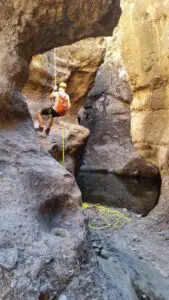
Apache Trail Canyon (Superstition Mountains)
Located in the Superstition Mountains, east of Phoenix.
Rated class 3B II. A technical canyon with some wading through pools, expecting to take about 3-5 hours. I’ve also seen this canyon rated 2A I for a non-technical canyon that doesn’t require rappels, and is sometimes dry. If you do it like a hike, you can skip the rappels and make it easier, however I recommend bringing a rope and enjoying the technical aspects of the canyon.
This is one of the first canyons that I did in Arizona. Apache Trail Canyon is a great beginner canyon for someone wanting to practice short rappels, routefinding, scrambling, and navigating boulders, downclimbing, and chokestones. It is perfect for a short half-day excursion; plan for 2-4 hours for this canyon.
The canyon is a shallow slot canyon with some twisty passages, a boulder field, a few small pools of water, and small caves to explore. Technical gear is recommended, but not required because it is possible to downclimb and bypass all of the rappels, with a bit of intermediate downclimbing and scrambling. But you came to canyoneer, not just to hike, so get out your rope and enjoy the rappels!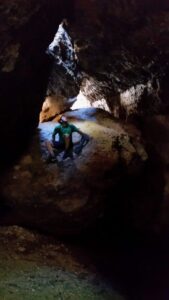
Apache Trail Canyon starts and ends with a little bushwhacking to get to the canyon. Steer clear of all the little cacti as you go in. There are 2 rappels, a 30 foot and a 20 foot. The first rappel is a 30 foot drop to enter the canyon into a pool of shallow water. You can usually accomplish the rappel by barely getting your feet wet, depending on conditions. Then you are in the canyon, follow it through the passages and up and over the boulders.
Stay a while and enjoy the boulder field that creates perfect caves for exploring. You might have to back track a few times before you find an exit through the boulder caves that doesn’t end in a steep drop off.
There’s not usually very much water in this canyon, just a few shallow pools that you’ll need to get your feet wet to wade through. You can do this canyon all year but summer can be hot and bring monsoon rains.
Near the end, the canyon widens and you’ll circle up towards the road. The hike out isn’t very pleasant. You need to carefully hike through the cacti forest again. If you find a faint trail you can follow it back to your car, otherwise just angle in the right direction and awkwardly bush whack. The second time I did this canyon was much faster because I was familiar with the obstacles, but part of the fun is navigating through the conditions. This is definitely a good one that you’ll enjoy. If you like Apache Trail Canyon, you’ll like the other 15-20 canyons in the vicinity of the Superstitions.
Find directions to Apache Trail Canyon here.
The Jug at Salome Creek (Payson)
Located near Payson in the Salome Wilderness Area.
Rating class 3B/C II. Technical canyoneering with rappels. Depending on the season there can be some stagnant pools of water or some currents and swimming. This is a short, half-day trip, but the approach requires a vehicle with high clearance, as well as a hot hike in of a couple of miles. Someday I’m going to bring a mountain bike to make it faster. (update- we biked the trail and it was awesome)
The Jug is a great trip to experience the lower section of Salome creek. It is a popular trip for some semi-technical canyoneering of a canyon with beautiful pink and white colored canyon walls.Experience granite walls, wading through pools, rock hopping, down climbing, and multiple swims. You’ll come across a natural water slide in the canyon. If there is enough running water, stay a while and spend time enjoying the water and sliding down. It’s basically a waterpark for adults, and is fairly well-known among the outdoors community.
There’s only one 70-foot rappel at the end of The Jug canyon, making the last part of this canyon the best. You’ll find a waterfall rappel into a deep pool of water, and several other long swims. The waterfall could be dry depending on water conditions. Anchors are available, but it’s also possible to downclimb a bit and then cliff-jump into the pool. Only jump after someone else has already tested water depth.
The pool is deep, so after rappelling you’ll need to tread water and swim while unhooking your belay device, don’t drop it. You can pull your rope all the way through to slip your belay device off the end and then swim with your belay device still attached (don’t tie a stopper knot on the end). Alternatively, use an 8 ring rigged for canyon mode, as described in this article .
.
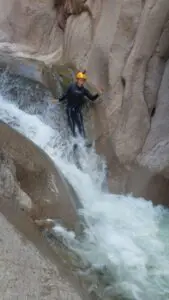
The Jug is best in spring and summer. During late summer the water will be stagnant and a gross color. Be careful during monsoon season in July-August with the amount of runoff water to create a possible strong current. If you aren’t doing the canyon in the summer, you’ll probably want a wetsuit. Make sure you bring dry bags  for the swims to protect your belongings. I would have better pictures of this canyon, but the last time I went through it claimed my camera…
for the swims to protect your belongings. I would have better pictures of this canyon, but the last time I went through it claimed my camera…
FYI- There is a 10 mile dirt road on the way to the canyon if you’re coming from Phoenix. Passenger cars could probably handle it, but you will probably want a 4-wheel drive car, or at least high clearance.
Find directions to The Jug at Salome Creek canyon here.
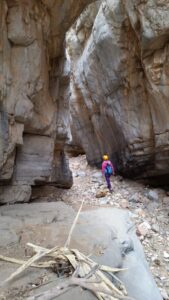
El Capitan (Globe)
Located near Globe, just under 2 hours east of Phoenix.
Rated class 3A II. Technical canyoneering in a typically dry canyon for a short, half-day canyoneering trip.
Meet the Arizona version of El Capitan, not to be confused with the more beautiful, and slightly more interesting sister, El Capitan in Yosemite, California.
El Capitan Canyon in Arizona is a great test canyon to bring beginner friends. It has many shorter rappels and down climb sections for a great canyon experience. Throughout the canyon you’ll come across 3 short rappels no longer than 50 feet. Depending on your ability to downclimb, you might have a few more rappels using natural anchors. The hike out follows a trail up an old dirt road. You may even run into some cows on your way in or out.
This is an enjoyable, quick canyon, plan on 2-5 hours depending on the ability of your group. Take your time and enjoy the cool tunnels and caves to explore. You won’t find any obstacles that are not easy to handle. I did this canyon the week before Christmas when I was 6 months pregnant! I wonder if I can bring my now 6-month old on this canyon… (mostly joking).
Find directions to El Capitan canyon here.
Southern Arizona
La Milagrosa Canyon (Tucson)
Located near Tucson in the Santa Catalina Mountains.
Rated class 3A I. Technical canyoneering in a typically dry canyon for a short 2-4 hour long canyoneering trip.
La Milagrosa Canyon is a mostly dry canyon with some possible small pools of water on a lucky day. Enjoy the hike in to this canyon as you wind through the beautiful desert saguaros. Before you descend into the canyon you can find an overlook with great views of the Tucson area from above the canyon. Throughout the canyon you will find 3 rappels. The longest one is 30 feet. These are great rappels for a beginner to practice. The box section is really cool, spend some time enjoying the area as you go. La Milagrosa canyon is best in the winter months- not so much in the spring.
Try the La Milagrosa and Agua Caliente Canyon loop for 2 amazing canyons in one day.
There is also some good rock climbing at this canyon, about 80 total routes.
Find directions to La Milagrosa Canyon here .
.
Hope you like some of these canyons. This post barely scratches the surface of all the amazing canyons that Arizona has to offer. Which good beginner canyons did I miss on this list?
See Also:
Is Canyoning Dangerous? Canyoneering Safety Tips

